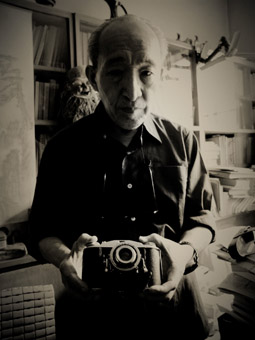china: alternative realities
dan edwards: the digital documentary filmmaker generation

Wang Jingyao, husband of Bian Zhongyun, with the camera he used to photograph his wife’s body in 1966 after she was murdered by Red Guards, in Hu Jie’s documentary Though I Am Gone (2006)
WHILE CHINA’S POLITICAL SYSTEM REMAINS DEEPLY AUTHORITARIAN, THE COUNTRY’S OVERWHELMING SIZE AND EXPLOSIVE GROWTH HAVE OPENED CAVERNOUS GAPS IN THE GOVERNMENT’S CONTROL OF CULTURE, THROUGH WHICH A NEW GENERATION OF DV-WIELDING DOCUMENTARY FILMMAKERS HAS CLIMBED.
“I’ve never heard an independent filmmaker in China ask themselves, ‘Can I do this?’,” comments Hong Kong-based producer David Bandurski. “Independent filmmaking is the freest avenue of expression that exists in China today.”
Independence from state-sanctioned channels of film production is the defining characteristic of a movement that encompasses a diverse array of styles and subject matter. “There were two things that made the change,” explains Beijing-based curator and filmmaker Ou Ning. “The first was pirate DVDs. People didn’t need to go to the Beijing Film Academy—they saw a lot of films through pirate DVDs, which gave them a very rich film history. When people saw this history they wanted to make things themselves, and they found there were cheap cameras that had come out. This technology has had a great impact on filmmaking in China.”
contemporary complexities
One of the most salient features of the shift in Chinese documentary filmmaking is the democratisation of the way contemporary reality is depicted on screen. “Before, history only had one version—by the Chinese Communist Party,” asserts Ou Ning. “Now with digital technology history has different versions.”
This trend is graphically illustrated by Meishi Street (2006), Ou Ning’s feature-length documentary depicting the plight of Beijing residents forcibly relocated from Dazhalan, an area just south of Tiananmen Square, in the lead-up to the 2008 Olympics. What begins as an observational work takes a fascinating turn when Ou Ning hands his camera to Zhang Jinli, an eccentric and outspoken restaurateur whose home and business are slated for demolition. From that point, Meishi Street becomes, in part, a film about the way digital technology is empowering ordinary Chinese citizens.
“After just one month I found he was not only shooting, but also narrating his story like a journalist,” recalls Ou Ning. “The most exciting thing for him was an occasion when he hung banners on the roof of his house. The police came to take down the banners…but when he put the camera on them they were very afraid…That made Zhang Jinli realise the camera is a weapon.”

The demolition of Dazhalan, a neighbourhood just south of Tiananmen Square and one of the oldest parts of Beijing, in Ou Ning's documentary Meishi Street (2006)
While Meishi Street depicts a small, if depressingly common drama of contemporary China, Du Haibin’s 1428 (2009) takes on a much larger subject. The devastating Sichuan earthquake of 2008 was the first domestic disaster of such magnitude since digital cameras had become readily available on the Chinese mainland. In the chaotic weeks following the quake, several independent filmmakers joined the uncontrolled flood of media personnel pouring into the disaster zone.
1428—named after the exact moment the quake struck on May 12—takes a cinema-verite approach, documenting as well as participating in the heartbreaking scenes playing out in Beichuan, a ruined town near the quake’s epicentre. The film reveals a complex, if at times overly disparate picture of overwhelming grief, graft, solidarity and merciless self-interest among the survivors, a far cry from the self-congratulatory tone of official Chinese media coverage at the time.
The gulf between China’s official media and independent documentaries like 1428 is most tellingly revealed in two scenes that bookend the film. Early on we see soldiers preventing villagers from entering Beichuan when a leader—probably Premier Wen Jiabao—visits the town, surrounded by a media circus. Towards the end of the film, Wen Jiabao returns to the area and an old man bitterly complains about the massive police and military presence preceding his arrival. A younger woman watching the scene remarks, “If you tell the truth, they’ll cut your words from the film.” But this is not state-controlled television, and the old man’s words remain.
the return of history
China’s digital filmmakers are not just claiming their right to document contemporary reality—they are also delving into repressed episodes from the nation’s recent past. Nanjing-based director Hu Jie is the most notable filmmaker working in this area, having produced two extraordinary works detailing stories from the first decades of the People’s Republic (unfortunately no subtitled version yet exists of a third film completed in 2008, National East Wind Farm).
In Search of Lin Zhao’s Soul (2004) looks at the life of a young writer through interviews with those who knew her. Initially an ardent supporter of the Communist revolution, Lin Zhao ran foul of authorities when she defended fellow Peking University students denounced during the Anti-Rightist campaign of 1957. She was expelled from the university and suffered various other indignities, which only hardened her resolve to speak out. She was imprisoned in 1960, but fought attempts to stifle her writing by penning an estimated 120,000 words of poetry and essays while in jail, using her own blood. In 1968 she was executed by firing squad.
Hu Jie stumbled upon Lin Zhao’s story by chance when working as a cameraman for China’s state news agency Xinhua. “I knew very little about the history of the 1950s and 60s,” the filmmaker explains. “While making Lin Zhao I had the sense that I was feeling around in the dark. Then I found the door of history, opened it and walked through. There I found a lot of ridiculous, cruel stories that really shocked me, and that was the motivation to go further.”
Hu’s next work focused on Bian Zhongyun, who in 1966 was the deputy headmistress of a prominent Beijing girls’ high school attended by many daughters of the party elite. The school was an early incubator of the Red Guard movement that spearheaded Mao’s Cultural Revolution from mid-1966, and on August 5 that year, Bian Zhongyun was beaten to death by her students and dumped in a rubbish cart. The incident marked her as one of the first victims of the revolutionary violence that within months would engulf the entire nation.
Bian’s elderly husband still lives in Beijing, and through the scholar Wang Youqin, Hu Jie discovered that he had secretly photographed the events leading up to his wife’s death and her brutally mauled body. It took six months of persuasion and a viewing of the Lin Zhao film to convince Bian’s traumatised husband to share his story and images with Hu Jie. These interviews and his photographs form the backbone of Though I Am Gone (2006), a profoundly moving memorial to the victims of Mao’s senseless political violence.
Hu Jie’s films are striking not only for the stories they reveal—horrific even by the grim standards of Chinese history—but also for the way they individualise events that have long remained broad, abstract historical episodes for want of recorded eye-witness accounts. More than this, Hu Jie makes these stories tangible. The climactic scene in both In Search of Lin Zhao’s Soul and Though I Am Gone sees the filmmaker uncovering physical traces of the long forgotten victims.
While making the Lin Zhao film, Hu Jie discovered the young woman’s ashes were stored in an unsealed box in Shanghai. Locating the box, he lifts the lid on camera, and finds wrapped in a newspaper of the 1960s a thick lock of Lin Zhao’s hair, turned prematurely grey by the tortures she endured. The final scene of Though I Am Gone sees Bian Zhongyun’s husband bring out a suitcase, unopened since 1966, containing the bloodied clothing he removed from Bian’s corpse the day she was murdered. These moldering objects, so carefully hidden for decades, insist with heartbreaking melancholy that we remember this history, and the injustices perpetrated in the name of Mao’s ideology.
a history unseen
China’s flourishing independent documentary sector illustrates how much the country has changed since the imprisoned Lin Zhao was compelled to pen essays in her own blood.
The fate of these films, however, reveals how little the Communist Party’s attitude has shifted when it comes to questions of culture. As David Bandurski explains, “[These films’ existence] is not at all a reflection of government tolerance. These works emerge from the chaos and uncertainty of a China in the midst of social transition. The chaos can offer opportunities for conscientious filmmakers…[but] control of all culture remains a top priority for China’s leadership.”
While controlling expression is increasingly difficult, the Chinese government is much more successful at limiting the dissemination of unsanctioned views. China’s independent documentaries are occasionally seen in small unofficial venues in major cities or on university campuses while informal networks of DVD distribution exist amongst artists, academics and activists. Generally, however, it is extremely difficult for these films to reach domestic audiences. Broadcast, official distribution or appearances at recognised film festivals within mainland China are out of the question. So although these films offer a tantalisingly uncensored vision of a country in flux, they also remain victims of the CCP’s obsessive desire to control the nation’s culture.
David Bandurski produced Zhao Dayong’s Ghost Town (RT94), available through dgenerate Films (http://dgeneratefilms.com). Ou Ning’s Meishi Street is available for online rental through the dgenerate Films website.
Hu Jie’s Though I Am Gone can be found in 10 parts with English subtitles on YouTube. In Search of Lin Zhao’s Soul is similarly available on YouTube, but unfortunately without English subtitles.
RealTime issue #96 April-May 2010 pg. 15






